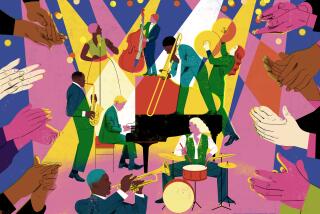JAZZ REVIEW : ‘Soul Support Concert’ at Cafe Lido Scores a Two-Bass Hit
- Share via
NEWPORT BEACH — If two heads are better than one, how about two basses? That was the premise Sunday at the Cafe Lido as keyboardist-composer Mark Davidson fronted a quintet for a pair of afternoon shows dubbed “The Soul Support Concert.”
The bassists in question? Andy Simpkins, highly regarded for his work with the George Shearing trio and as a founding member of the Three Sounds, brought both funk and finesse to the proceedings. Luther Hughes, a protege of Simpkins’ longtime associate Gene Harris, contrasted his partner’s woody tones on upright with his own electric ring. The resulting sound was deep and rich and full of surprisingly inventive moments of interplay.
Davidson’s setup, which included dual percussionists as well--drummer Ray Brinker and percussionist Kurt Rasmussen--not only found the basses up front frequently as soloists, but also put focus squarely on the piano.
Davidson brought a playful, sometimes mischievous solo style to the outing, descriptions that just as well apply to his compositions. He seldom followed the straight-and-narrow when improvising, instead running around inside the tunes looking to stir up trouble. Even pretty numbers like his own “Fond Regret” had quirky, sometimes sinister underpinnings in the form of riotous chordal splash or long, uneasy lines.
Despite this kid-at-the-playground enthusiasm, Davidson’s tunes showed a clear sense of structure, an almost inevitable circular construction with logically built climaxes and recurring points of reference. His playing shows these same type of contours with plenty of peaks and vistas. He likes to go all out, with wide dynamic swings and rollicking endings in almost every tune.
Hughes sat out the second show’s first number, Davidson’s “True Blues,” a mid-tempo exercise highlighted by Simpkins’ strong, melodic solo work. The bassist utilized the full range of his instrument, but stated his most impressive lines from deep in the basement. He stuck in occasional up-range, double-note plucks that served as accent to a quick-paced run, or to neatly echo Rasmussen’s conga pacing.
“The Ladies of the Champs Elysees” opened with a stately, classical-sounding line embellished with Rasmussen’s chimes and bells. But the tune abruptly dissolved into a raunchy walk powered by Brinker’s strong burlesque accompaniment and Simpkins’ gut-bucket strut. Davidson worked a contemporary barrel-house statement while Hughes added lyricism and some sharp, upper-range flash.
Written for this two-bass concert, Davidson’s “Running Back” galloped along on Brinker’s in-the-saddle attack, embellished with Rasmussen’s ring and rattle. A moody, minor-key statement from Davidson was contrasted by Hughes’ lighter touch. The bassist even worked some of “You’d Be So Nice to Come Home To” into his solo. Simpkins took the more daring approach, picking long, involved lines that reflected Davidson’s seriousness.
Brinker was featured on Davidson’s “Flag Twirlers,” a mid-tempo theme that broke into a driving, upbeat cooker. The drummer built a tom-heavy line into an onslaught of bass pounds and cymbal play before the keyboardist brought the tune back to earth.
Though the percussionists sat out Davidson’s “Bass Solo,” there was plenty of rhythmic current to sustain the piece. Hughes, playing with considered lines and sliding accents, took an almost trumpet-like solo over Simpkins’ pulse and the keyboardist’s soft-touch accompaniment. At no time else during the concert was the melding of the bassist’s sound more magical.
Some of that magic was lost when Hughes switched to his acoustic for an encore of “Sonny.” Though the give-and-take established by the two bassists continued, the subtle contrast in their sounds did not. The result was a cluttered feel in the low end during ensemble passages, less so during solos.
Some identity was restored when Hughes picked up his bow during the resounding build that brought the tune to a close. The contrasting personalities of the bassists and the character of their sounds is what made this pairing interesting. As this final tune showed, Hughes and Simpkins were wise to exploit their tonal differences.
More to Read
The biggest entertainment stories
Get our big stories about Hollywood, film, television, music, arts, culture and more right in your inbox as soon as they publish.
You may occasionally receive promotional content from the Los Angeles Times.








